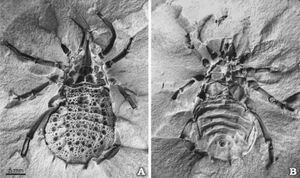Biology:Eophrynus prestvicii
| Eophrynus prestvicii | |
|---|---|

| |
| Fossil of Eophrynus prestvicii (BU 699, Lapworth Museum, University of Birmingham, UK), whitened with ammonium chloride to improve contrast. A. Dorsal view. B. Ventral view. | |
| Scientific classification | |
| Kingdom: | |
| Phylum: | |
| Class: | |
| Order: | |
| Family: | |
| Genus: | |
| Species: | Eophrynus prestvicii (Buckland, 1837)
|
Eophrynus prestvicii is an extinct species of arachnid belonging to the order Trigonotarbida.
Historical background
The first trigonotarbid was described in 1837 from the Coal Measures of Coalbrookdale in England by the famous English geologist Dean William Buckland.[2] He believed it to be a fossil beetle and named it Curculoides prestvicii. A much better preserved example was later discovered from Coseley near Dudley; also in the English West Midlands conurbation. Described in 1871 by Henry Woodward,[3] he correctly identified it as an arachnid and renamed it Eophrynus prestvicii – whereby the genus name comes from ἠώς (eos, meaning 'dawn'), and Phrynus, a genus of living whip spider (Amblypygi).
Description
Eophrynus prestvicii can reach a length of about 2.5 centimetres (0.98 in). These arachnids were similar to modern spiders, but they could not produce silk. Recent x-ray imaging revealed that Eophrynus prestvicii were covered by protective spikes on the back-half of its body. This creature had long legs enabling it to run and hunt on the forest floor.[4] Scientists at Imperial College London created a detailed 3D computer model of the arachnid from fossils.[5][6]
Distribution
This species is known from a handful of good quality fossils preserved inside siderite concretions. Fossils of this species have been found in the Carboniferous sediments of United Kingdom.
References
- ↑ The Paleobiology Database
- ↑ William Buckland (1837). Treatise IV. Geology and mineralogy with reference to natural theology. The Bridgewater treatises on the power, wisdom and goodness of God as manifested in the creation. (2nd ed.). London: William Pickering.
- ↑ H. Woodward (1871). "On the discovery of a new and very perfect Arachnide from the ironstone of the Dudley Coal-field". Geological Magazine 8 (9): 1–4.
- ↑ "X-rays bring extinct spiders back to life". Planet Earth online. 5 August 2009. http://planetearth.nerc.ac.uk/news/story.aspx?id=497. Retrieved 2014-06-11.
- ↑ Science Daily
- ↑ Russell Garwood, Jason A. Dunlop & Mark D. Sutton (2009). "High-fidelity X-ray micro-tomography reconstruction of siderite-hosted Carboniferous arachnids". Biology Letters 5 (6): 841–844. doi:10.1098/rsbl.2009.0464. PMID 19656861.
- Jason A. Dunlop and Russell J. Garwood Tomographic reconstruction of the exceptionally preserved trigonotarbid arachnid Eophrynus prestvicii
- An arachnid of the Carboniferous
Wikidata ☰ Q5381841 entry
 |

